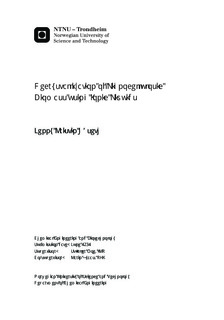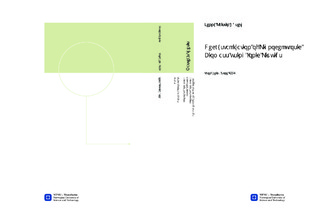| dc.description.abstract | This thesis is written in fulfilment of the requirements for a Master in Science at the Norwegian University of Science and Technology (NTNU), Department of Chemical Engineering. The work investigates the effectiveness of pretreatment of norway spruce and sugarcane bagasse with the ionic liquid 1-ethyl-3-methylimidazolium acetate ([EMIM][OAc]). The effect of pretreatment temperature and reaction time was evaluated. Enzymatic hydrolysis yield was used as the main evaluation parameter. Norway spruce was pretreated at 80, 100, and 120 °C for 3, 6, 12, and 24 hours. The sugarcane bagasse raw material was pretreated at the same temperatures for 1 and 3 hours. UV-Vis spectrophotometric analysis was used to determine the amount of lignin removed during the pretreatment. The regenerated solids from the pretreatment was hydrolysed enzymaticly and the digestibility was determined using High-Performance Liquid Chromatography (HPLC). The pretreatment caused an increase in the enzymatic digestibility for both spruce and bagasse. This effect is believed to arise from a decrease in the crystallinity of the cellulose and an increase in the accessible surface area caused by the increased porosity of the pretreated material. The digestibility results for spruce shows that, at shorter pretreatment times, higher temperatures are favourable. However, at longer reaction times, too high temperatures can give a reduction in the digestibility. The optimal reaction condition for spruce was in this work found to be 100 °C for 12 hours, giving a digestibility close to 90 wt% of the added glucan. For sugarcane bagasse the optimum was not found, and experiments using harsher conditions was proposed. When comparing the results for pretreatment of spruce with that of bagasse it appear that spruce needs harsher conditions to achieve the same glucan yield as bagasse. The results of the analysis of the enzymatic digestibility of hemicelluloses (mannan for spruce and zylan for bagasse) concurs very well with the results for glucan presented above. Regarding the removal of lignin from the biomass, it was found that the degree of delignification in these pretreatment experiments was so low it could be neglected. The low degree of lignin removal was also evident in the darkening of the regenerated biomass from pretreatments using relatively harsh reaction conditions. This darkening was put down to the lignin undergoing condensation reactions. Suggestions for further work on this area include a thorough investigation into the thermal stability of different ionic liquids at prolonged reaction times and high temperatures, as well as an investigation of the delignification effect of different ionic liquids. As mentioned earlier, pretreatment experiments with bagasse using harsher conditions can also be useful. | nb_NO |

